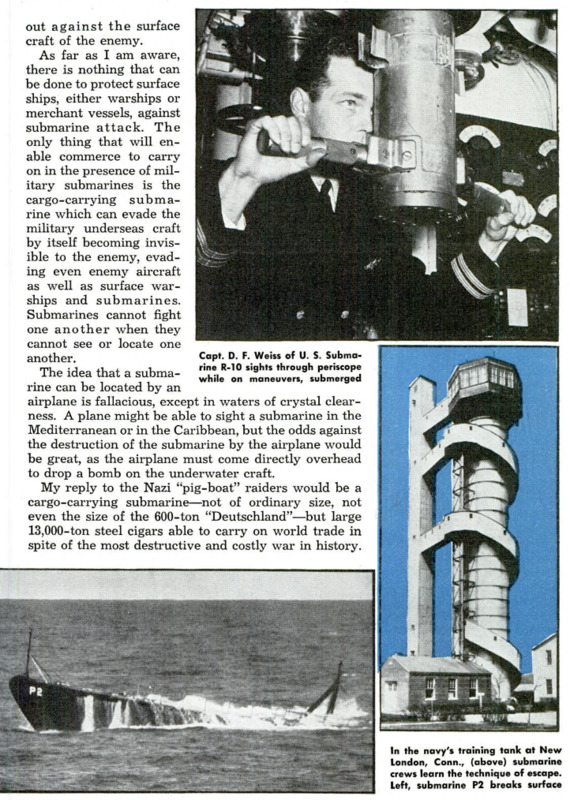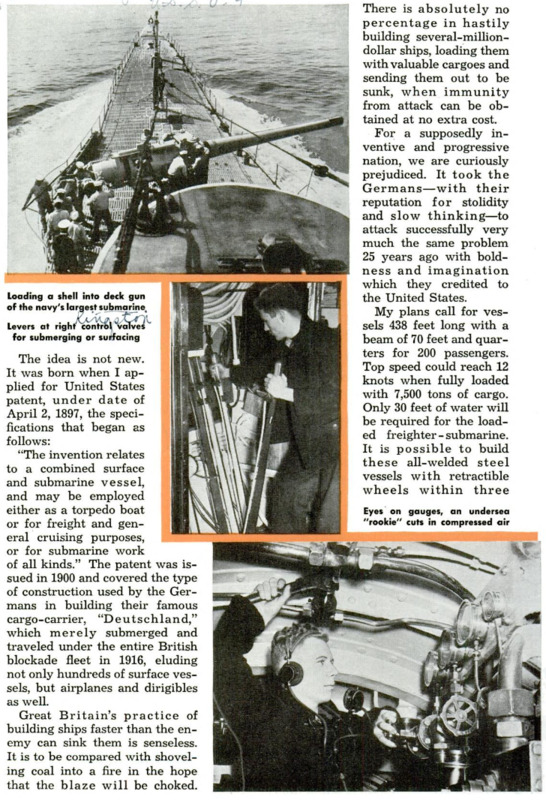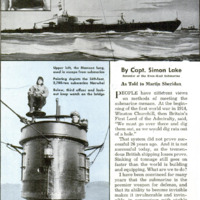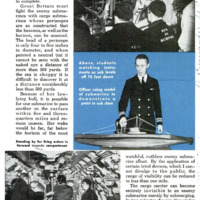PEOPLE have ditterent views on methods of meeting the submarine menace. At the beginning of the first world war in 1914, Winston Churchill, then Britain’s First Lord of the Admiralty, said, “We must go over there and dig them out, as we would dig rats out of a hole.” That system did not prove successful 26 years ago. And it is not successful today, as the tremendous British shipping losses prove. Sinking of tonnage still goes on faster than the world is building and equipping. What are we to do? I have been convinced for many years that the submarine is the premier weapon for defense, and that its ability to become invisible makes it invulnerable and invincible, in comparison with visible surface craft. Some submarines, through the carelessness of their commanders or through improper installation of machinery, may be caught, but in general the physical differences are such that, in the long run, the submarine must win out against the surface craft of the enemy. As far as I am aware, there is nothing that can be done to protect surface ships, either warships or merchant vessels, against submarine attack. The only thing that will enable commerce to carry on in the presence of military submarines is the cargo-carrying submarine which can evade the military underseas craft by itself becoming invisible to the enemy, evading even enemy aircraft as well as surface warships and submarines. Submarines cannot fight one another when they cannot see or locate one another. The idea that a submarine can be located by an airplane is fallacious, except in waters of crystal clearness. A plane might be able to sight a submarine in the Mediterranean or in the Caribbean, but the odds against the destruction of the submarine by the airplane would be great, as the airplane must come directly overhead to drop a bomb on the underwater craft. My reply to the Nazi “pig-boat” raiders would be a cargo-carrying submarine - not of ordinary size, not even the size of the 600-ton “Deutschland” - but large 13,000-ton steel cigars able to carry on world trade in spite of the most destructive and costly war in history. The idea is not new. It was born when I applied for United States patent, under date of April 2, 1897, the specifications that began as follows: “The invention relates to a combined surface and submarine vessel, and may be employed either as a torpedo boat or for freight and general cruising purposes, or for submarine work of all kinds." The patent was issued in 1900 and covered the type of construction used by the Germans in building their famous cargo-carrier, “Deutschland,” which merely submerged and traveled under the entire British blockade fleet in 1916, eluding not only hundreds of surface vessels, but airplanes and dirigibles as well. Great Britain’s practice of building ships faster than the enemy can sink them is senseless. It is to be compared with shoveling coal into a fire in the hope that the blaze will be choked. There is absolutely no percentage in hastily building several-million-dollar ships, loading them with valuable cargoes andsending them out to be sunk, when immunity from attack can be obtained at no extra cost. For a supposedly inventive and progressive nation, we are curiously prejudiced. It took the Germans - with their reputation for stolidity and slow thinking – to attack successfully very much the same problem 25 years ago with boldness and imagination which they credited to the United States. My plans call for vessels 438 feet long with a beam of 70 feet and quarters for 200 passengers. Top speed could reach 12 knots when fully loaded with 7,500 tons of cargo. Only 30 feet of water will be required for the loaded freighter-submarine. It is possible to build these all-welded steel vessels with retractible wheels within three months after the materials are delivered at the shipyard. A standard type surface freighter of the same load-carrying capacity would cost more to build and require a longer time to complete. Great Britain must fight the enemy submarines with cargo submarines whose periscopes are so constructed that the heavens, as well as the horizon, can be scanned. The head of a periscope is only four to five inches in diameter, and when painted a neutral tint it cannot be seen with the naked eye a distance of more than 500 yards. If the sea is choppy it is difficult to discover it at a distance considerablyless than 500 yards. Because of her low-lying hull, it is possible for one submarine to pass another on the surface within five and three-quarters miles and remain unseen. Her wake would be far, far below the horizon of the most watchful, ruthless enemy submarine afoat. By the application of certain tried devices, which I cannot divulge to the public, the range of visibility can be reduced to less than one mile. The cargo carrier can become entirely invisible to an enemy submarine merely by submerging. In two minutes she can dive under water. And no matter how rough the surface may be due to stormy weather, there is always smooth sailing from 30 feet down. When the Germans made two round trips to this country in submarines during the first world war, they offered us a lesson that we failed to learn. Here were two small undersea craft that made round trips between the United States and Germany, carrying more than 500 tons of cargo through districts where thousands of vessels kept a sharp watch. The British navy knew when the “Deutschland” was scheduled to leave Baltimore. Several destroyers waited outside the three-mile limit to sink the U-boat. But the “Deutschland” dropped out of sight before reaching the three-mile zone and eluded them all. In the current offensive against British shipping lanes none of us knows exactly how many submarines the Germans are using, but she must have at least 200 of the destructive craft. From extensive 24-hour submergence tests I have found that with 15 cubic feet of free uncontaminated air per hour per man at normal atmospheric pressure, men could live comfortably for long periods. My proposed merchant submarine could be transformed into an air-conditioned troop transport for 2,500 men and their equipment. Perhaps the Germans intend to try to invade Britain in this manner. Such transports could safely make long voyages even through surface-patrolled areas as they have the ability to take on invisibility at will by submerging to zones of quiet and safety beneath the sea. There are many other uses for the cargo submarine, aside from running the blockade. As freighters they can open up the route north of Russia and Siberia and thus enable a ship to treble her profits in trading between English and other European ports and certain important Oriental ports. They will open up a territory of more than three million square miles by the use of the rivers that empty into the Arctic Ocean and drain northern Russia and Siberia, which are rich in natural products and have great agricultural possibilities. They will solve the problem for Britain of getting out mineral and agricultural products from northern Canada. Submarines have done more damage than can be imagined. Ever since 1920 I have been campaigning to limit military submarines in the following respects: eliminate the deck guns, reduce their size and their radius of action to 1,000 miles, so they could not embark on long privateering and destructive voyages, but would have sufficient range and seaworthiness to enable them to protect their hame waters. My son, Thomas A. Edison Lake, is building a 30-foot fest model of his new armed torpedo boat with aerodynamic principles of marine construction. It is intended to seek out enemy submarines and destroy them with depth bombs and other secret devices. He and I worked together for years developing the submarine. Now we are devising means of offsetting the effectiveness of enemy undersea craft. His creation has an airplane-type fuselage built on three pontoons - two forward and one aft. A knee-action unit practically eliminates shock. The fuselage rides clear of the water, with the two forward pontoons each carrying engine and shaft leading to a marine propeller. Steering is accomplished by the operator’s control of the rear pontoon. When completed, the test torpedo boat is to be demonstrated before representatives of the Navy. The full-size torpedo boat will be 90 feet long, carrying four 2l-inch torpedo tubes, four gun turrets, and means for laying mines and discharging depth bombs. His vessel will give greater ease of handling than the present torpedo boats which provide unsteady platforms from which to fire guns or discharge torpedoes. I regret that so many of my inventions have been used by certain governments as destructive weapons of warfare instead of constructive instruments for recovering more of the natural products which Mother Earth has provided so lavishly for the benefit of mankind under the sea and which can so easily be secured by a properly designed submarine. Iam looking forward to the day when nations will use submarines as defenders rather than offenders, and as commercial cargo-carrying units. If China had a defensive underwater fleet of only four submarines, she would have been able to keep Japanese troopships from landing near Shanghai. And before Great Britain can hope to carry on near-normal trade in face of the stiff submarine offensive of the enemy, she must fall back on the submarine-freighter - or be starved out!








